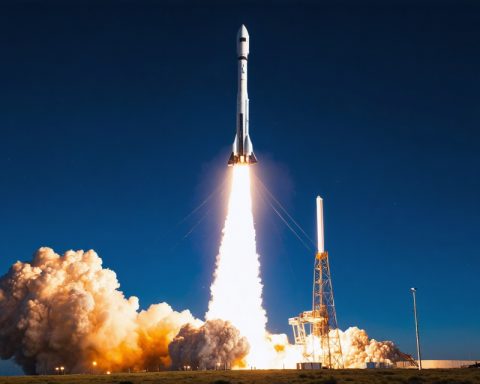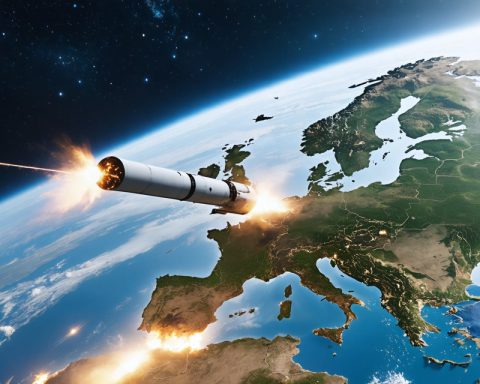- SpaceX plans to increase rocket launches near Hawaii, raising environmental concerns over marine sanctuaries.
- The expansion involves launching up to 25 rockets annually, threatening areas near Papahānaumokuākea Marine National Monument.
- Critics fault the FAA for outdated assessments, prompting fears of environmental damage from debris and toxic substances.
- Local communities, environmental groups, and Native Hawaiian leaders demand stricter oversight and thorough studies on potential impacts.
- Activism and legal actions from organizations like the Surfrider Foundation highlight the need for accountability and environmental protection.
- The movement calls for a balance between technological advancement and the preservation of Earth’s natural and cultural treasures.
As the molten rays of a Hawaiian sunset illuminate the vast Pacific, a different kind of fire is brewing in the hearts of island residents and environmental protectors. The calm waves of ancient marine sanctuaries, home to vibrant reefs and elusive marine life, face a new threat from far above. SpaceX, Elon Musk’s ambitious space enterprise, has propelled plans to expand rocket launches, with potential fallout zones perilously close to the sanctified waters of Papahānaumokuākea Marine National Monument.
Hawaiians, joined by fervent environmental advocates, express mounting unease. The Federal Aviation Administration’s draft assessment allows SpaceX to increase launches from five to a staggering 25 annually. Alarmingly, the trajectory of some colossal Starship rockets veers toward marine zones near Indonesia, Western Australia, South America, and dangerously near Hawaii’s own protected marine treasures.
The imagery is stark: seas strewn with debris and auroras of toxicity invading the intricate tapestry of life below. Critics chastise the FAA for its reliance on outdated evaluations that paint overly optimistic scenarios. What happens if a rocket veers off course or disintegrates improperly? The potential devastation includes toxic spills in crystal waters and threats to both marine life and the cultural heritage of Native Hawaiians.
With rising voices, environmental groups, Native Hawaiian leaders, and local communities rally for urgent action. They seek rigorous oversight and demand comprehensive studies to better understand potential fallout. Grassroots activism, supported by rigorous legal challenges from organizations like the Surfrider Foundation, presses for accountability.
The struggle extends beyond Hawaii’s shores, urging everyone to participate in crafting a future where cutting-edge technology and serene natural ecosystems coexist. Engage, advocate, and stand with the islands—a resonant call for harmony between the ambitions of outer space and the irreplaceable treasures of Earth.
SpaceX Launches: A Threat or Opportunity for Hawaii’s Marine Sanctuaries?
How-To Steps & Life Hacks
1. Advocating for Environmental Protection:
– Join or support local environmental advocacy groups such as the Surfrider Foundation in their efforts to protect marine sanctuaries.
– Participate in public comment periods for FAA assessments to voice concerns about environmental impacts.
2. Staying Informed:
– Subscribe to updates from environmental organizations and local news outlets for the latest developments regarding SpaceX launches and marine protections.
– Follow SpaceX’s official announcements and FAA reports to understand upcoming launch schedules and impact studies.
3. Sustainable Practices:
– Support sustainable tourism initiatives that minimize ecological footprints while promoting Native Hawaiian culture and heritage.
– Encourage community engagement by hosting or participating in educational workshops focused on local ecology and space technology.
Real-World Use Cases
– Increased Monitoring of Marine Life: Utilize technologies like drones and underwater robotics to monitor marine life in potential fallout zones, ensuring rapid response plans in case of contamination.
– Legal and Scientific Collaborations: Foster collaborations between environmental lawyers and marine scientists to develop framework-based assessments that balance technological advancements with environmental conservation.
Market Forecasts & Industry Trends
– Growth in the Commercial Space Sector: The space industry is rapidly expanding, with projections suggesting a market value of over $600 billion by 2030. This growth will demand stronger regulations to manage environmental impacts effectively.
– Environmental Technology Investment: Rising concerns about space-related environmental impacts are expected to increase investment in environmental technology and conservation programs.
Reviews & Comparisons
– SpaceX vs. Alternatives: While SpaceX leads in reusable rocket technology, competitors like Blue Origin focus on eco-friendly space travel with less intrusive environmental footprints.
Controversies & Limitations
– Ecological Impact: Critics argue that FAA assessments fail to adequately address the long-term ecological impact of increased rocket launch frequency, especially in sensitive marine areas.
– Potential Harm to Cultural Heritage: The encroachment on Native Hawaiian lands and waters raises cultural and ethical concerns, complicating the environmental narrative.
Features, Specs & Pricing
– Starship Specifications: SpaceX’s Starship is designed for long-duration space missions with the capability to carry over 100 metric tons. Its size and power raise questions about safe proximity to inhabited and ecological zones.
Security & Sustainability
– Risk Management: SpaceX is urged to adopt advanced simulation technologies to mitigate risks associated with rocket trajectories and potential malfunctions.
– Sustainability Initiatives: Emphasizing sustainability, SpaceX aims to use reusable rockets, but impact assessments are necessary to evaluate the full environmental footprint.
Insights & Predictions
– Future Regulations: Stricter regulations and comprehensive environmental studies are predicted as public and governmental scrutiny increases for space launch activities near sensitive ecosystems.
Tutorials & Compatibility
– Educational Resources: Online platforms offering courses on environmental science and aerospace technology can empower local communities to engage with and influence policy-making.
Pros & Cons Overview
Pros:
– Promotes advancements in space technology.
– Enables efficient, cost-effective space missions.
Cons:
– Potential ecological threats to marine sanctuaries.
– Cultural and community opposition from Native Hawaiian groups.
Actionable Recommendations
– Community Engagement: Support grassroots movements and participate in local government hearings to advocate for environmental assessments.
– Policy Influence: Encourage dialogue between stakeholders, including scientists, policy-makers, and indigenous leaders, ensuring diverse perspectives inform decision-making.
– Educational Initiatives: Increase awareness through educational campaigns about the potential impacts of space activities on marine ecosystems.
For further research and involvement in environmental advocacy, visit the Surfrider Foundation for resources and action steps.
By balancing technological growth with environmental stewardship, we can navigate toward a future where the wonders of space coexist with the Earth’s natural marvels.







